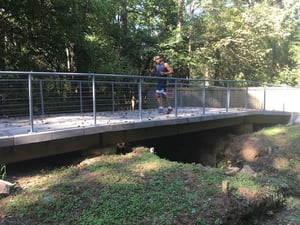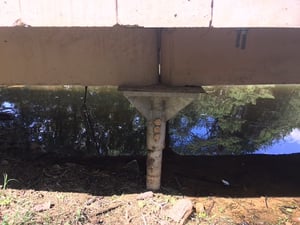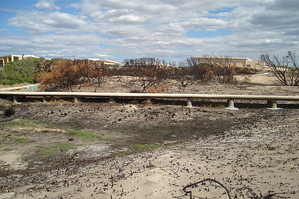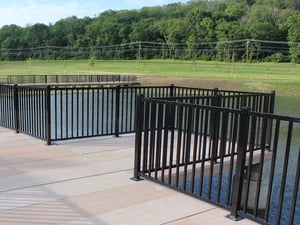 If you’re working on a trail project in a wetland area, you have two options for your design: reroute the trail for a longer path or go through the wetland with a boardwalk. Wetland boardwalks can be tricky, especially with permitting restrictions and environmental factors to examine. Here are four topics to consider before you design your next wetland boardwalk project.
If you’re working on a trail project in a wetland area, you have two options for your design: reroute the trail for a longer path or go through the wetland with a boardwalk. Wetland boardwalks can be tricky, especially with permitting restrictions and environmental factors to examine. Here are four topics to consider before you design your next wetland boardwalk project.
Consideration #1: Environmental Impact
Minimizing impact to the environment should be one of the highest priorities when designing a wetland boardwalk. There are a few ways to reduce a boardwalk’s footprint, while creating a pathway for people to enjoy for years to come.
The Foundation System
 When designing a wetland boardwalk, the idea is to create an elevated walkway, not a dam. For these elevated boardwalks, the foundation system you choose will be a key factor in the environmental impact.
When designing a wetland boardwalk, the idea is to create an elevated walkway, not a dam. For these elevated boardwalks, the foundation system you choose will be a key factor in the environmental impact.
In wetland areas, helical piles and composite piles are a great low-impact solution. They require minimal equipment to install and are gently screwed into the soil. Timber or concrete piles tend to be larger and more invasive solutions, which typically aren’t ideal for these delicate environments. In some cases, permitting doesn’t allow for penetrating the ground. Precast concrete piers are often a good low-impact solution in these situations, as they do not require digging.
Alternative Routes
Sometimes, the project site isn’t conducive to an elevated walkway, and other options need to be considered. “Traversing the wetland is not always the best option. You can get people close to the wetland to experience it without actually impacting the wetland itself,” said Michael Henn, PLA, of Kudela & Weinheimer Landscape Architects. Henn suggested considering a trail around the sensitive area, rather than going straight through it, even if that means a longer path.
Construction
Looking at your method for construction is another important aspect to guarding the wetland environment. Each wetland is different, therefore permitting will be different for almost every project.
For some projects, top down construction—where the boardwalk is installed by equipment operating on top of previously installed treads and beams—is going to be a great option. This will prevent equipment from being driven directly on a wetland.
Consideration #2: Material Selection
It’s impossible to discuss protecting wetlands without talking about the materials used in construction. Timber often has a lower front-end cost and matches the natural aesthetics of a wetland area, but the environmental impacts of chemically treated wood leaching into wetlands may not be worth the upfront savings.
There are more environmentally friendly alternatives to traditional timber boardwalks, such as precast concrete and composite decking. Outside of the environmental concerns, there are some other materials-related considerations that are specific to wetland boardwalks.
Durability & Maintenance
Before deciding which material is the best fit for your unique boardwalk project, take some time to compare materials, looking at durability and maintenance costs.
Timber is going to be a lower upfront cost solution, though it will require maintenance and replacements as the wood warps, splinters, and rots over time. Composite decking has a lower maintenance cost than timber and is more resistant to, although not immune from, rotting and warping. Concrete will not warp, splinter, or decay, and requires no ongoing maintenance after installation.
Fire Resistance
 Fire resistance for a boardwalk might not be important for every environment, but wetlands occasionally experience prescribed burns to repair areas overrun with invasive species, prevent wildfires, or revitalize the soil. Consider whether the material you choose should be noncombustible.
Fire resistance for a boardwalk might not be important for every environment, but wetlands occasionally experience prescribed burns to repair areas overrun with invasive species, prevent wildfires, or revitalize the soil. Consider whether the material you choose should be noncombustible.
This recent article from Australia shares about ancient rock art at Carnarvon National Park that was destroyed when a boardwalk made of recycled plastic exploded. The boardwalk was made from recycled material—a great decision from an environmental perspective—but choosing a different product could have prevented the devastating loss.
In a portion of this video, landscape architect and conservationist, Karina Veaudry, discusses why she likes specifying PermaTrak’s precast concrete system in her projects as often as possible.
Consideration #3: Boardwalk Usage
Texture might not be one of the first things that comes to mind when designing a boardwalk, but it’s an important piece to acknowledge. Since bikers and runners often utilize boardwalks like this, ensuring their safety is very important. Research which materials will quickly become slippery or grow algae in high moisture areas.
Precast concrete comes in different textures, including slip-resistant textures, which provides a less dangerous surface in all weather conditions. Check out these videos from the McMullen Greenway in North Carolina to see the impact of the skid resistant texture.
Consideration #4: Aesthetic Design
Depending on your role in the boardwalk project, you may be more or less interested in the aesthetic design of a wetland boardwalk. For landscape architects, it’s usually an important aspect of the design process.
Enhance the Natural Beauty
 Henn recommended making the design less about the boardwalk and more about the area you’re experiencing. You can do this through neutral color options or by adding overlooks or observation piers at natural stopping points to admire the scenery. On that same note, rather than creating a line from point A to point B, consider a boardwalk design that curves to fit the area best.
Henn recommended making the design less about the boardwalk and more about the area you’re experiencing. You can do this through neutral color options or by adding overlooks or observation piers at natural stopping points to admire the scenery. On that same note, rather than creating a line from point A to point B, consider a boardwalk design that curves to fit the area best.
Materials play a role in the aesthetic design as well. As stated earlier, timber blends naturally into wetlands, while concrete can have a colder, less natural appearance. There are color and texture options with precast concrete (even some that look like wood planks) that can help soften the appearance.
Choosing railings that are transparent is a great way to help the boardwalk to enhance, rather than take away from, the natural beauty of a wetland. Don’t be afraid to mix materials- If you choose a material like concrete for the boardwalk itself, you could even consider timber for the railings to help the boardwalk blend in with the environment. Remember, railings can be replaced easily over time, but the boardwalk should be sturdy and durable.
Check out some of our PermaTrak wetland project profiles for additional ideas for your next wetland boardwalk.





